The most wonderful rocket
The anniversary of the launch of the first satellite will be in October, but today, May 15, 60 years ago the rocket first flew into the sky, which put it into orbit. The famous "seven", which ensured the succession of victories of the Soviet Union in space, which delighted the whole world, is celebrating its 60th anniversary today at the "workplace" - rockets based on it fly now and will fly at least ten years at least. One can argue for a long time which carrier rocket is the best, but, in my opinion, the title of the most remarkable rocket definitely belongs to the R-7 family. The G7 was designed without exaggeration by brilliant people. And in the design of the rocket, you can still find the results of their witty, talented and sometimes paradoxical decisions.

One of the first launches of the R-7, photo from the archive TSENKI
Modern boosters are pragmatic to boredom. Cylindrical steps, at best, end with a protrusion of the above-caliber fairing, and sometimes somewhere a dull flat surface breaks the projecting pipeline. Against this background, the "seven" with conical side blocks and the second stage of complex shape looks like a real beauty.

Steps of the Soyuz launch vehicle, photo from the Progress TsSKB booklet / cosmopark.ru
')
The photo clearly shows that the central unit (second stage) in the upper part is wider than in the lower part. In addition, if you look closely, it is noticeable that the upper part of the central block is conical, and the stage first expands and then narrows.

Vostok rocket on VDNKh, photo by Sergei Arssenev / Wikimedia Commons
If you think about it, side blocks also raise questions. Besides the fact that they are conical, and, therefore, less fuel will fit in them than in cylindrical ones of the same height, many modern rockets do not use side blocks at all. Why did they appear on the "seven"?
The R-7, which, according to the index of the Main Missile-Artillery Directorate, 8K71, was supposed to be an intercontinental ballistic missile, and carry a 5.4-ton hydrogen bomb to a distance of 8240 kilometers. Soviet designers already knew how to make single-stage rockets flying at 1,200 km (P-5), but simple calculations showed that one stage would not be enough for such a range and payload. A theoretical solution - multistage rockets - was proposed as early as the beginning of the 20th century by Tsiolkovsky, but its practical implementation immediately posed a huge number of problems for engineers. The most obvious option, to put the second stage above the first, meant that the engine of the second stage would have to be turned on at high altitude, in conditions of almost vacuum and weightlessness. No one has yet known how the launching rocket engine will behave. Therefore, it was decided to install the first steps of the package around the second. In this case, all five engines were launched on Earth, under electrical control of ground systems, and, only if everything was in order, did the rocket detach from the launch pad.
The decision to package the rocket with a “package” gave rise to many new problems, because the designers, instead of one rocket, actually had five. The engineers, accustomed to the rocket that was free-standing on the launch pad, first designed four separate tables for the side blocks, and were going to transport the rocket to the launch in an upright position. And the side blocks themselves initially wanted to make cylinders with a height of 20.92 m. But the idea looked bad already on the drawings. The transporter looked bulky, complicated and expensive, four separate tables unacceptably loaded the central unit, and, moreover, a small wind threatened to knock over the rocket. A combat missile could not wait for good weather. Palliative solutions like building a wall around the start looked ugly and poorly solved the problem. It was necessary to come up with something fundamentally new.
In flight, the force from the side blocks was transmitted to the power frame of the central unit in its upper part. And there was a very elegant idea to use the element already existing on the rocket in the launch structure. The rocket was hung in the middle so that on the launch pad it experienced loads that almost coincided with the flight ones.

Fastening assembly side unit with a pocket under the launch equipment bracket, photo KIK USSR

Kronshteyn launch facilities, photo KIK USSR
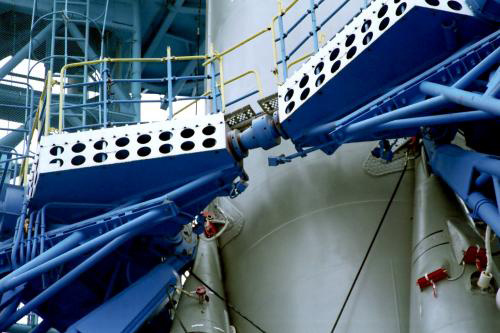
Rocket in the launch facility, photo KIK USSR
Also, the side blocks made conical and reduced their length by 1.3 m. Such a decision, firstly, reduced the requirements for the speed of removal of power supports, and secondly, shifted the pressure center back in flight, facilitating the operation of the control system.
Hanging the rocket “by the side” also solved the problem of wind load - it became possible to lower the tail section under the launch structure, hiding it from the wind and get rid of the “Chinese wall” around the launch.

Launch structure, drawing from the KBOM archive
Irrational conveyor also managed to eliminate, replacing the vertical assembly and transportation to the horizontal. The installation unit has become light and elegant.
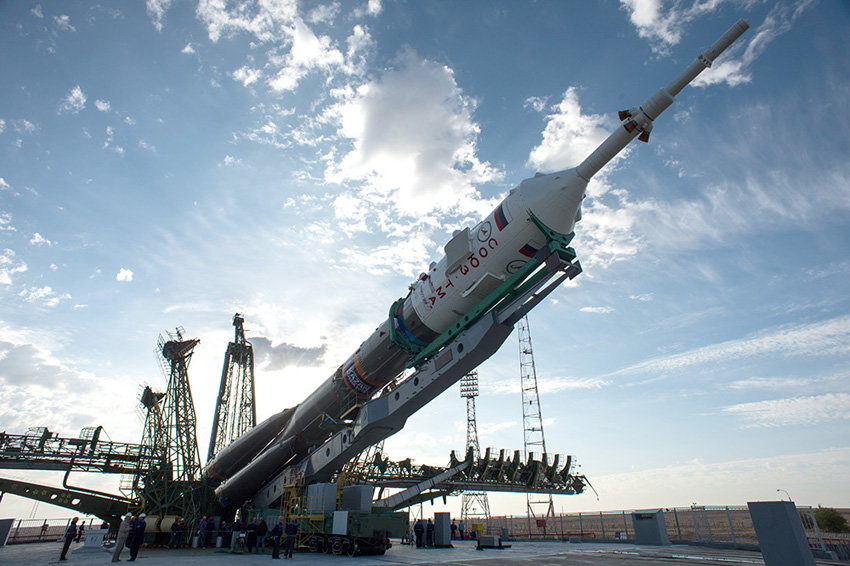
Installation of the Soyuz launch vehicle into the launch facility, photo by Ramil Sitdikov / RIA Novosti
“The most reliable mechanism is the mechanism that is missing” - these words are attributed to Vladimir Barmin, the chief designer of the launch facilities. And according to this aphorism, the R-7 family of rockets is close to absolute reliability, because many actions are performed not by special mechanisms, but by tamed gravity.
The start of the “sevens” is implemented simply and reliably to the genius. When starting the side blocks inevitable scatter thrust. In this case, large disturbing moments may arise, and the “late” unit could at worst fall out of the package. Synchronize engine start using the 50s was impossible. But they managed to get around this problem beautifully - the side blocks, when launched, reached an intermediate stage of thrust, smaller than the mass of the rocket. The disturbing moments were parried by the farms of the launch facility. If everything was in order, the engine of the central unit was started. The total thrust of the engines exceeded the weight of the rocket, and it began to rise. When the rocket rose to 49 millimeters, the brackets of the launch pillars emerged from the mounts, and the rocket appeared in free flight. And from the intermediate stage to the full draft, the side blocks passed more easily and reliably, which allowed to do this already in flight.
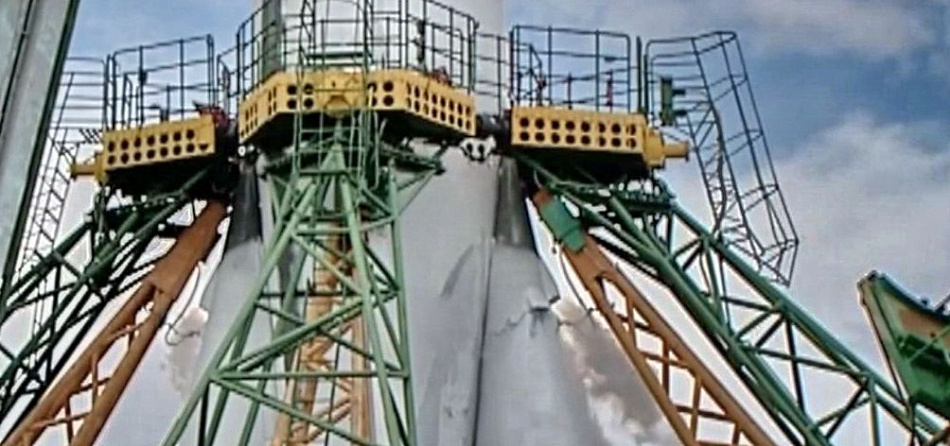
The rocket has slightly risen, the supports are already beginning to move forward, the freeze-frame from the video is made by the USSR CIC

ESA video start animation
And the power pylons and cable masts are retracted under the influence of gravity - they have large and heavy counterweights.
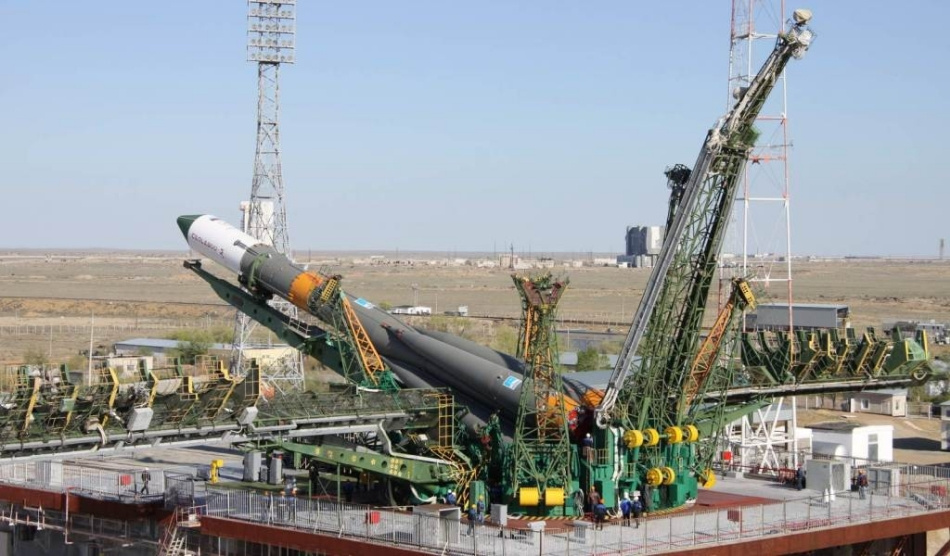
Counterbalances - yellow cylinders, photos of Roskosmos
The separation of the side blocks is also done simply to the genius. Before separation, the engines of the side blocks are transferred to lower thrust, and the steering engines are turned off. Then the lower power connections in the tail of the rocket are broken.

Lower power connections, photo by KIK USSR
The engines of the side blocks are specially arranged at an angle to the block axis.

Block axis and direction of engine thrust, USSR KIC scheme
Therefore, after breaking the power connections, the blocks begin to turn.
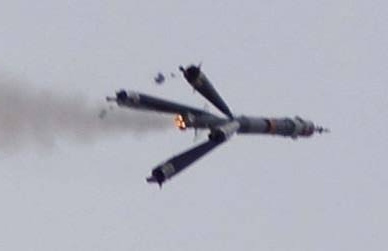
Photo KIK USSR
Then the side block motors are turned off. The engine of the central unit (second stage) continues to work, and the side units under their weight simply fall out of the mounts. Immediately after the mechanical connection is broken, the drain valve of the oxygen tank opens, and the side blocks begin to twist.
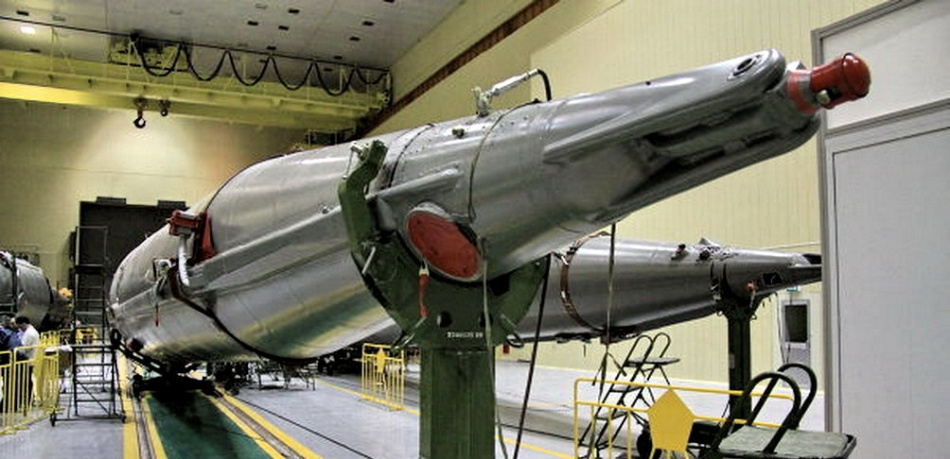
Drain valve under the red safety cap in the center, photo KIK USSR
Only in the 21st century, on-board cameras were installed on the Soyuz, and we were able to see closely how beautiful it is.

ESA video animation
I recommend to look at the unique footage of the regular and emergency divisions on the KIK USSR website .
American and Soviet rocket and space technology borrowed a lot from German trophies inherited after the end of World War II. And if the Americans got the chief designer of the V-2, Werner von Braun, with most of his team, the USSR’s catch was more modest — missile spare parts and second-tier designers like Helmut Grettrup. However, sometimes they skip the accusations that, allegedly, Soviet designers did not develop rockets on their own, but stole the ideas of German designers. If you wish, you can even find pictures on the Internet, allegedly of the Grettrup project, suspiciously similar to the P-7.

Figure astronautix.com
Anyone who was even interested in the history of space technology knows that even formally a copy of the V-2, the Soviet R-1, was already different from it in that it was modified for production in the USSR and used other materials. And starting from the P-2, the Soviet designers pushed the Germans aside and began to go their own way. Grettrup was released from the USSR as early as 1953, before the development of the R-7 began, keeping him in isolation for several years, and the G-5 was a cruise project, not a ballistic missile. So the charges of plagiarism are completely unfounded. But, at the same time, I know in the “seven” two things that still carry the German mark.
The first is the start key, which turns the last manual command to launch the rocket. The designers, creating R-7 starting systems consoles, wanted to install a more modern-looking switch, but the military, who were used to the “start-up” command, were asked to leave the mechanical key.

The key to start at the Museum of Cosmonautics, photo from LJ yellow-reporter
The second is the idea of driving a turbopump assembly from the catalytic decomposition of hydrogen peroxide. In the presence of a catalyst, concentrated peroxide was converted into hot water vapor, and the released energy rotated the turbines feeding the engine components of the fuel. The concept was used both on the V-2 and on the Soviet R-1, R-2, R-5, still alive on the R-7 family, and only on subsequent rockets was abandoned. In the 1950s, it was a simple, compact and reliable, though not the most effective option, and now it looks like an anachronism. In more modern rockets there are gas generators in the form of small combustion chambers that use the same components and from the same tanks as the main engine. But it is already too late to upgrade engines and change the design, the engine reliability has been literally cosmic for hundreds of start-ups, so the peroxide gas generator will fly on the G-7 until the end of its operation.

Gas generator, drawing lpre.de
When the design of the R-7 one rocket actually turned into five, there was a problem of uneven fuel consumption. No matter how hard they tried to produce the same engines, then and now the thrust and consumption of the components of a specific engine instance will be in a certain range. On the technique of the 50s, tens of tons of fuel would be lost, and the rocket would experience asymmetrical loads from different mass of side blocks. Therefore, we had to make a special synchronization system for emptying tanks.
If the reliability of one rocket unit is 0.9, then, since a normal flight requires the work of all five, the reliability needs to be multiplied, and the total reliability would be 0.9 5 , that is, 0.59, which is completely unacceptable. And this is not taking into account the reliability of the control system, separation system, etc. The designers had to drastically improve the reliability of the systems - all that was possible, not only duplicated, but also put three identical systems with voting (majorization). And the fact that it was impossible to duplicate, for example, engines, was subjected to ground testing and testing. In fact, having created the R-7, the Soviet rocket men reached a qualitatively new level of ensuring the reliability of technical systems.
An elegant solution that has become traditional for Soviet and Russian space technology was invented by engine operators. It was not possible to create an engine with a large combustion chamber and the parameters required for the R-7. And in smaller combustion chambers, the processes were clearer and more manageable. One large chamber was replaced by four small ones, and the benefit from increasing the efficiency of the engine outweighed the losses from an increase in its mass. On the original "seven" it turned out as many as 32 combustion chambers - 20 marching and 12 steering.

Transportation of the Soyuz launch vehicle to the launch, photo by NASA
Reliably ignite 32 combustion chambers is not an easy task. Due to the fact that in the first and second stages the engines are started on the ground, it became possible to realize a very simple and cheap solution - pyrotechnic checkers with an electric fuse on wooden mounts.
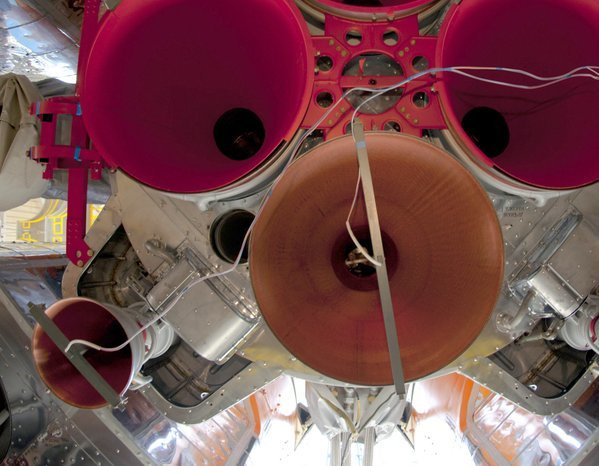
Piercing devices on wooden mounts
Representing themselves, in fact, giant matches, piercing devices cost a penny, and allow the engine to start reliably - if the bomb fails to ignite for some reason, the control system will receive information about it and stop the launch of the rocket. The reliability of the system is such that the launch of the rocket due to poor ignition is canceled less than once a decade.
But I saved the most amusing feature of the R-7 family at last. The “Seven” is probably the only existing carrier rocket, where, before the start, the staff manually rotates the turbopump units of the engines using the “curved starter”, as on older cars.

Top view of the turbopump unit, the RSC Energia museum , own photo
On R-7, liquid oxygen is used as an oxidizing agent. It is very cold and tends to freeze everything it can reach. The turbopump assembly is heated before the start, but to make sure that it does not have ice on it and that it can rotate freely, the staff opens a small hatch on the side of each unit, inserts a starter into the hole, and turns it.

Manual throttle hatch, RSC Energia museum, own photo
Sixty years is a long time for a technical system. Of course, the rocket has since been repeatedly upgraded, and, despite all the archaic elements of the structure, remains effective and competitive. And the reliability gained by hundreds of starts will be extremely difficult to beat. Already in the 21st century, two new starts appeared for it - in Kourou and on Vostochny. Beautiful, brilliant, complex, simple and paradoxical - all this is our most wonderful “seven”.
Related items on the "invisible complexity" tag

One of the first launches of the R-7, photo from the archive TSENKI
Soviet beauty
Modern boosters are pragmatic to boredom. Cylindrical steps, at best, end with a protrusion of the above-caliber fairing, and sometimes somewhere a dull flat surface breaks the projecting pipeline. Against this background, the "seven" with conical side blocks and the second stage of complex shape looks like a real beauty.

Steps of the Soyuz launch vehicle, photo from the Progress TsSKB booklet / cosmopark.ru
')
The photo clearly shows that the central unit (second stage) in the upper part is wider than in the lower part. In addition, if you look closely, it is noticeable that the upper part of the central block is conical, and the stage first expands and then narrows.

Vostok rocket on VDNKh, photo by Sergei Arssenev / Wikimedia Commons
If you think about it, side blocks also raise questions. Besides the fact that they are conical, and, therefore, less fuel will fit in them than in cylindrical ones of the same height, many modern rockets do not use side blocks at all. Why did they appear on the "seven"?
The R-7, which, according to the index of the Main Missile-Artillery Directorate, 8K71, was supposed to be an intercontinental ballistic missile, and carry a 5.4-ton hydrogen bomb to a distance of 8240 kilometers. Soviet designers already knew how to make single-stage rockets flying at 1,200 km (P-5), but simple calculations showed that one stage would not be enough for such a range and payload. A theoretical solution - multistage rockets - was proposed as early as the beginning of the 20th century by Tsiolkovsky, but its practical implementation immediately posed a huge number of problems for engineers. The most obvious option, to put the second stage above the first, meant that the engine of the second stage would have to be turned on at high altitude, in conditions of almost vacuum and weightlessness. No one has yet known how the launching rocket engine will behave. Therefore, it was decided to install the first steps of the package around the second. In this case, all five engines were launched on Earth, under electrical control of ground systems, and, only if everything was in order, did the rocket detach from the launch pad.
The decision to package the rocket with a “package” gave rise to many new problems, because the designers, instead of one rocket, actually had five. The engineers, accustomed to the rocket that was free-standing on the launch pad, first designed four separate tables for the side blocks, and were going to transport the rocket to the launch in an upright position. And the side blocks themselves initially wanted to make cylinders with a height of 20.92 m. But the idea looked bad already on the drawings. The transporter looked bulky, complicated and expensive, four separate tables unacceptably loaded the central unit, and, moreover, a small wind threatened to knock over the rocket. A combat missile could not wait for good weather. Palliative solutions like building a wall around the start looked ugly and poorly solved the problem. It was necessary to come up with something fundamentally new.
In flight, the force from the side blocks was transmitted to the power frame of the central unit in its upper part. And there was a very elegant idea to use the element already existing on the rocket in the launch structure. The rocket was hung in the middle so that on the launch pad it experienced loads that almost coincided with the flight ones.

Fastening assembly side unit with a pocket under the launch equipment bracket, photo KIK USSR

Kronshteyn launch facilities, photo KIK USSR

Rocket in the launch facility, photo KIK USSR
Also, the side blocks made conical and reduced their length by 1.3 m. Such a decision, firstly, reduced the requirements for the speed of removal of power supports, and secondly, shifted the pressure center back in flight, facilitating the operation of the control system.
Hanging the rocket “by the side” also solved the problem of wind load - it became possible to lower the tail section under the launch structure, hiding it from the wind and get rid of the “Chinese wall” around the launch.

Launch structure, drawing from the KBOM archive
Irrational conveyor also managed to eliminate, replacing the vertical assembly and transportation to the horizontal. The installation unit has become light and elegant.

Installation of the Soyuz launch vehicle into the launch facility, photo by Ramil Sitdikov / RIA Novosti
Tamed gravity
“The most reliable mechanism is the mechanism that is missing” - these words are attributed to Vladimir Barmin, the chief designer of the launch facilities. And according to this aphorism, the R-7 family of rockets is close to absolute reliability, because many actions are performed not by special mechanisms, but by tamed gravity.
The start of the “sevens” is implemented simply and reliably to the genius. When starting the side blocks inevitable scatter thrust. In this case, large disturbing moments may arise, and the “late” unit could at worst fall out of the package. Synchronize engine start using the 50s was impossible. But they managed to get around this problem beautifully - the side blocks, when launched, reached an intermediate stage of thrust, smaller than the mass of the rocket. The disturbing moments were parried by the farms of the launch facility. If everything was in order, the engine of the central unit was started. The total thrust of the engines exceeded the weight of the rocket, and it began to rise. When the rocket rose to 49 millimeters, the brackets of the launch pillars emerged from the mounts, and the rocket appeared in free flight. And from the intermediate stage to the full draft, the side blocks passed more easily and reliably, which allowed to do this already in flight.

The rocket has slightly risen, the supports are already beginning to move forward, the freeze-frame from the video is made by the USSR CIC

ESA video start animation
And the power pylons and cable masts are retracted under the influence of gravity - they have large and heavy counterweights.

Counterbalances - yellow cylinders, photos of Roskosmos
The separation of the side blocks is also done simply to the genius. Before separation, the engines of the side blocks are transferred to lower thrust, and the steering engines are turned off. Then the lower power connections in the tail of the rocket are broken.

Lower power connections, photo by KIK USSR
The engines of the side blocks are specially arranged at an angle to the block axis.

Block axis and direction of engine thrust, USSR KIC scheme
Therefore, after breaking the power connections, the blocks begin to turn.

Photo KIK USSR
Then the side block motors are turned off. The engine of the central unit (second stage) continues to work, and the side units under their weight simply fall out of the mounts. Immediately after the mechanical connection is broken, the drain valve of the oxygen tank opens, and the side blocks begin to twist.

Drain valve under the red safety cap in the center, photo KIK USSR
Only in the 21st century, on-board cameras were installed on the Soyuz, and we were able to see closely how beautiful it is.

ESA video animation
I recommend to look at the unique footage of the regular and emergency divisions on the KIK USSR website .
German Heritage Paradoxes
American and Soviet rocket and space technology borrowed a lot from German trophies inherited after the end of World War II. And if the Americans got the chief designer of the V-2, Werner von Braun, with most of his team, the USSR’s catch was more modest — missile spare parts and second-tier designers like Helmut Grettrup. However, sometimes they skip the accusations that, allegedly, Soviet designers did not develop rockets on their own, but stole the ideas of German designers. If you wish, you can even find pictures on the Internet, allegedly of the Grettrup project, suspiciously similar to the P-7.

Figure astronautix.com
Anyone who was even interested in the history of space technology knows that even formally a copy of the V-2, the Soviet R-1, was already different from it in that it was modified for production in the USSR and used other materials. And starting from the P-2, the Soviet designers pushed the Germans aside and began to go their own way. Grettrup was released from the USSR as early as 1953, before the development of the R-7 began, keeping him in isolation for several years, and the G-5 was a cruise project, not a ballistic missile. So the charges of plagiarism are completely unfounded. But, at the same time, I know in the “seven” two things that still carry the German mark.
The first is the start key, which turns the last manual command to launch the rocket. The designers, creating R-7 starting systems consoles, wanted to install a more modern-looking switch, but the military, who were used to the “start-up” command, were asked to leave the mechanical key.

The key to start at the Museum of Cosmonautics, photo from LJ yellow-reporter
The second is the idea of driving a turbopump assembly from the catalytic decomposition of hydrogen peroxide. In the presence of a catalyst, concentrated peroxide was converted into hot water vapor, and the released energy rotated the turbines feeding the engine components of the fuel. The concept was used both on the V-2 and on the Soviet R-1, R-2, R-5, still alive on the R-7 family, and only on subsequent rockets was abandoned. In the 1950s, it was a simple, compact and reliable, though not the most effective option, and now it looks like an anachronism. In more modern rockets there are gas generators in the form of small combustion chambers that use the same components and from the same tanks as the main engine. But it is already too late to upgrade engines and change the design, the engine reliability has been literally cosmic for hundreds of start-ups, so the peroxide gas generator will fly on the G-7 until the end of its operation.

Gas generator, drawing lpre.de
Difficult, simple and unusual
When the design of the R-7 one rocket actually turned into five, there was a problem of uneven fuel consumption. No matter how hard they tried to produce the same engines, then and now the thrust and consumption of the components of a specific engine instance will be in a certain range. On the technique of the 50s, tens of tons of fuel would be lost, and the rocket would experience asymmetrical loads from different mass of side blocks. Therefore, we had to make a special synchronization system for emptying tanks.
If the reliability of one rocket unit is 0.9, then, since a normal flight requires the work of all five, the reliability needs to be multiplied, and the total reliability would be 0.9 5 , that is, 0.59, which is completely unacceptable. And this is not taking into account the reliability of the control system, separation system, etc. The designers had to drastically improve the reliability of the systems - all that was possible, not only duplicated, but also put three identical systems with voting (majorization). And the fact that it was impossible to duplicate, for example, engines, was subjected to ground testing and testing. In fact, having created the R-7, the Soviet rocket men reached a qualitatively new level of ensuring the reliability of technical systems.
An elegant solution that has become traditional for Soviet and Russian space technology was invented by engine operators. It was not possible to create an engine with a large combustion chamber and the parameters required for the R-7. And in smaller combustion chambers, the processes were clearer and more manageable. One large chamber was replaced by four small ones, and the benefit from increasing the efficiency of the engine outweighed the losses from an increase in its mass. On the original "seven" it turned out as many as 32 combustion chambers - 20 marching and 12 steering.

Transportation of the Soyuz launch vehicle to the launch, photo by NASA
Reliably ignite 32 combustion chambers is not an easy task. Due to the fact that in the first and second stages the engines are started on the ground, it became possible to realize a very simple and cheap solution - pyrotechnic checkers with an electric fuse on wooden mounts.

Piercing devices on wooden mounts
Representing themselves, in fact, giant matches, piercing devices cost a penny, and allow the engine to start reliably - if the bomb fails to ignite for some reason, the control system will receive information about it and stop the launch of the rocket. The reliability of the system is such that the launch of the rocket due to poor ignition is canceled less than once a decade.
But I saved the most amusing feature of the R-7 family at last. The “Seven” is probably the only existing carrier rocket, where, before the start, the staff manually rotates the turbopump units of the engines using the “curved starter”, as on older cars.

Top view of the turbopump unit, the RSC Energia museum , own photo
On R-7, liquid oxygen is used as an oxidizing agent. It is very cold and tends to freeze everything it can reach. The turbopump assembly is heated before the start, but to make sure that it does not have ice on it and that it can rotate freely, the staff opens a small hatch on the side of each unit, inserts a starter into the hole, and turns it.

Manual throttle hatch, RSC Energia museum, own photo
Conclusion
Sixty years is a long time for a technical system. Of course, the rocket has since been repeatedly upgraded, and, despite all the archaic elements of the structure, remains effective and competitive. And the reliability gained by hundreds of starts will be extremely difficult to beat. Already in the 21st century, two new starts appeared for it - in Kourou and on Vostochny. Beautiful, brilliant, complex, simple and paradoxical - all this is our most wonderful “seven”.
Related items on the "invisible complexity" tag
Source: https://habr.com/ru/post/403881/
All Articles